Lovely Xmas eve lunch @therabbit_hotel. Love that it is dog friendly!

Source: Jonathan Rea On Facebook
Lovely Xmas eve lunch @therabbit_hotel. Love that it is dog friendly!

Source: Jonathan Rea On Facebook
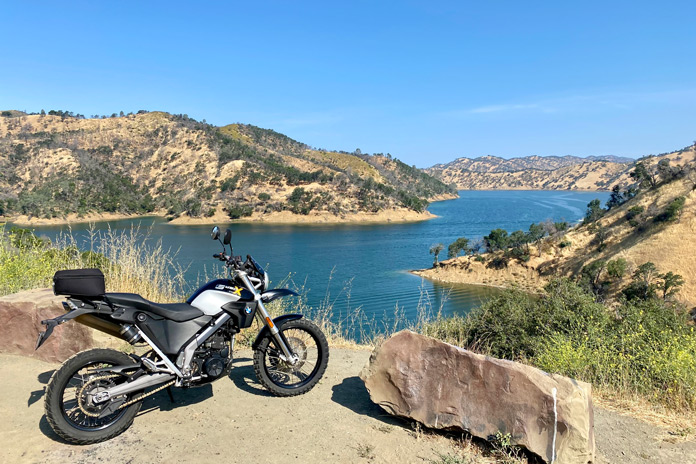
This is a tale of two amazing rides. One threads its way through some of Northern California’s beautiful wine, lake, and hill country. The other winds its way through my very being to the center of my heart.
Recently, my wife and I traveled to California’s Sonoma wine country to attend a ceremony in which our son‑in‑law, Lt. Col. Joffre Lander, assumed command of a squadron at Travis Air Force Base. Since I don’t like to be far from a motorcycle when traveling, I took my BMW G 650 X‑Country along for the trip.
During a lull in the military and familial activities, I snuck the BMW out for a loop ride through the golden hills and grapevine‑lined terrain in the Sonoma region. I rolled out of Vacaville on Interstate 80 to reach the sweeping corners of narrow, scenic Wooden Valley Road, which is lined by trees and passes through rolling grasslands and vineyards.
The turn onto State Route 121 provided even more varied terrain as rock outcroppings added texture to the ride. Various wineries staked their claims with stone archways and beckoning signage. As SR-121 morphed into State Route 12 on my approach to the town of Sonoma, the density of wineries increased.
Scan QR code above or click here to view the route on REVER
When I threw down my kickstand at Sonoma Plaza, I had no idea of the historical significance of the town of just over 10,000 souls. Across the street from the beautiful centerpiece park rests the Sonoma State Historic Park, which is a cluster of historic sites. It’s an open and easy stroll through locations like the Mission San Francisco Solano, Sonoma Barracks, Toscano Hotel & Kitchen, and other fascinating buildings.
After walking back to the vibrant green shade of the 8‑acre Sonoma Plaza, I stood in the shadow of the impressive Bear Flag Monument, which commemorates the spot where the Bear Flag Party raised the Bear Flag and declared California free from Mexican rule in 1846. After a walk around Sonoma City Hall in the center of the plaza, I continued my clockwise loop ride.
See all of Rider‘s California U.S. tour stories here.
SR‑12 led me to Trinity Road and other narrow, winding byways that are thoroughly entertaining, curvaceous rolls beneath trees, beside cliffs, and over hills, often with panoramic views.
After passing through Oakville and Rutherford, I headed farther east on State Route 128. This stretch was arguably the most beautiful part of an already spectacular ride. I rolled past Lake Hennessy, Lake Berryessa, and several family wineries. Finally, I headed south back to Vacaville and to my daughter’s home. Would this be the end of my tale? Hardly.
In 2011, I welcomed my first granddaughter into this world. I vividly remember the overwhelming love I felt when I held little Skya for the first time. The tiny black‑haired treasure in my arms was so perfect and so lovely that I was instantly and indelibly smitten.
Over the dozen years since she was born, I have taken Skya on many short motorcycle rides around the yard or the block with her planted securely in front of me on the saddle. She has grown from a fragile cherub to a vibrant, smart, lovely pre‑teen, and motorcycle rides have been a vital part of our deep and loving connection.
On this occasion, Skya was waiting when I rolled into my daughter’s garage. As we sat and talked, it became clear she was ready for her first longer motorcycle ride. Parental permission was secured, and I fitted Skya in my wife’s riding gear. We discussed what it takes to be a safe and secure passenger on the back of a motorcycle.
With a wave to her mother and grandmother, Skya and I headed north for a loop ride. Almost instantly, she found the groove and became a settled “sack of potatoes” on the back of the BMW. The repeated portion of my earlier route took on a new significance as I could feel the wonder Skya was experiencing. She would occasionally tap me to point things out, and as we flipped up our faceshields to talk, I could see the joy in her green eyes.
We stopped often to decide on routes, take in views, and just chat. At one stop, I pointed out the smooth, pale hills on the horizon. I mentioned that they reminded me of Hills Like White Elephants, a short story by Ernest Hemingway, and I recommended that she read it someday. Back on the motorcycle, Skya chose the routes, including a long road to a dead end that gave us both a laugh.
I have ridden thousands of miles in my lifetime, and the miles that Skya and I shared that day are some of the most significant. We agreed that when she gets a few more years under her belt, we will reconvene for an extended ride. We can’t wait.
See all of Rider‘s touring stories here.
The post Sonoma Motorcycle Rides, On My Own and With Family | Favorite Ride appeared first on Rider Magazine.
Source: RiderMagazine.com
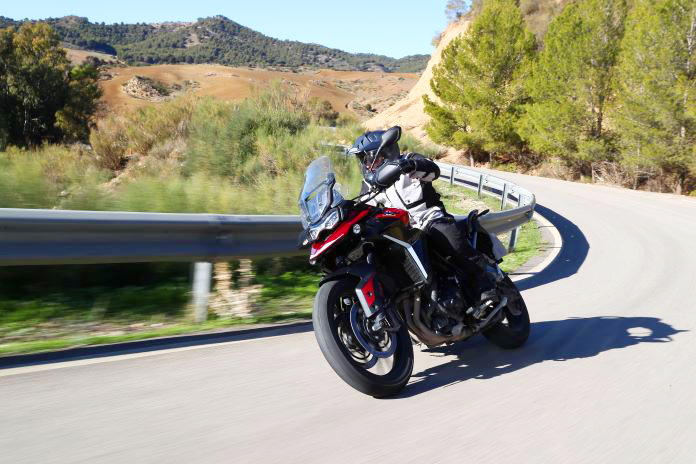
Middleweight adventure bikes are perhaps the hottest segment in motorcycling – even if the definition of “middleweight” keeps creeping upward. It’s why Triumph has given its lauded Tiger 900 a revamp just four years after its introduction, gaining a 13% boost in power from its inline-Triple, plus new TFT instrumentation, sharper styling, and updated electronics. The pursuit of perfection at Triumph continues.
The Tiger 900 slots into a market full of a highly diverse crop of ADVs, and Triumph is cleverly aiming for two types of customers with the Tiger 900s. The GT and GT Pro versions skew toward the sport-touring market – let’s call it the sport-adventure category. Bikes in this class typically use cast-aluminum wheels with 19-inch fronts. Unchanged for 2024 but still in the lineup is the road-biased Tiger 850 Sport.
Related: Triumph Tiger 850 Sport Road Test
The Tiger 900 Rally Pro is intended for tackling off-road terrain, using a 21-inch front tire and riding on wire-spoke wheels. It will do battle with bikes like the Ducati Desert-X and the Austrian stablemates of KTMs and Husqvarnas in their various middleweight guises.
Related: 2020 Triumph Tiger 900 GT Pro and Rally Pro First Ride Review
All Tiger 900s come equipped with cruise control, heated grips, machined adventure footpegs cushioned by removable rubber inserts, and four ride modes: Rain, Road, Sport, and Off-Road, the latter switching off rear ABS. Pro models get a customizable Rider mode and enjoy clutchless up- and downshifts with a quickshifter, as well as a centerstand and tire-pressure monitoring. Triumph no longer offers the Rally in a non-Pro variant nor the GT Low.
Related: Triumph Tiger 900 GT Low Tour Test Review
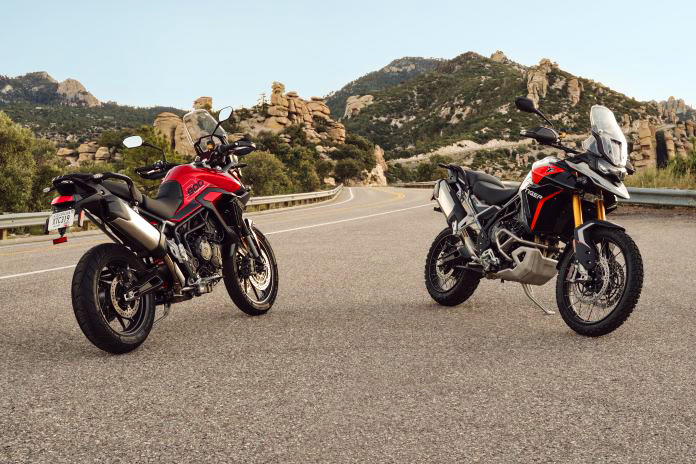
The existing Tiger 900s were already admirable machines that are capable, versatile, and stylish – more than 45,000 have been sold. At the new bikes’ presentation, Triumph boiled down the new Tigers’ key points: more performance, capability, comfort, and attitude.
To give us a chance to put the Tigers through their paces, Triumph invited us to southern Spain for two days of riding. The first day would be entirely on asphalt in the hills north of Málaga, while the second day was spent almost entirely off-road on some amazingly twisty and scenic trails in El Torcal de Antequera nature preserve.
Triumph treats its 900 Pro buyers to heated seats and grips as standard equipment, both godsends when it’s chilly like it was when we set off shortly after dawn. Fingers were kept cozy on heating elements behind the standard handguards, while my buns got so toasty I shut down the seat heat after only an hour. Surely I would’ve survived without the extra heat, but a comfy rider is a happy rider.
Another aspect that makes a happy rider is more power – I’ve never met an engine that wouldn’t be better with a bump in ponies, assuming low-end grunt isn’t marginalized. Kudos to Triumph for redesigning its 888cc engine just four years after it debuted, giving it 13 extra horsies for a peak of 107 hp – two higher than KTM’s venerable 890. This will surely please my friend Glenn, who bought a GT Pro on my recommendation a few years ago. His only complaint is that he wished it had more oomph when he was two-up with his wife.
Engineers made several major tweaks to unleash more power, including a new cylinder head with larger inlet ports and optimized oval exhaust ports working in partnership with higher-lift camshafts. New pistons bump the compression ratio to 13:1. Harvesting additional low-end power are 15mm longer intake trumpets. Peak torque is up 2.2 lb-ft to 66.4 at 6,850 rpm.
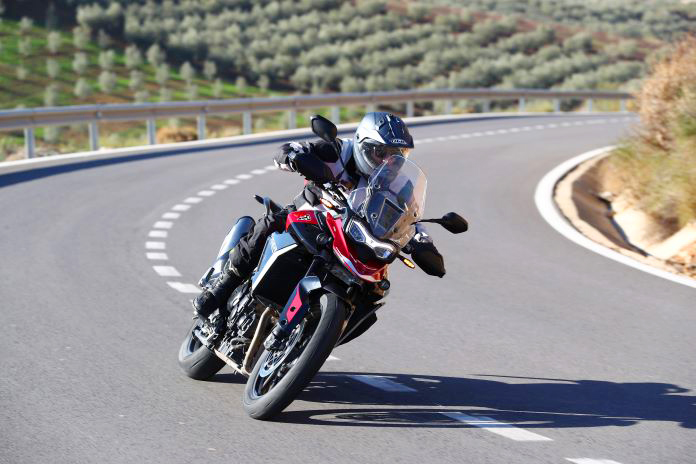
From behind the bars and if you’re not in much of a hurry, Triumph’s unique T-plane Triple doesn’t feel much different. A dyno chart reveals the old engine has an imperceptible edge in grunt until 4,500 rpm before the new engine boasts clear superiority the rest of the way to redline, especially around 7,500 rpm when the previous motor begins to peter out and the new one continues surging to its 9,500-rpm peak. There was nothing wrong with the previous powerplant, but this new one is clearly superior and adds a compelling upper-rev swell the old mill lacked.
Adding to the impression of speed is the pleasantly authoritative bark from a lighter and freer-flowing exhaust system, which somehow gets by with the loss of its second catalyzer near the rider’s foot, helping to lighten the system. Incredibly, Triumph claims the more powerful motor has 9% better emissions and fuel economy, netting a 264-mile range from the 5.3-gallon fuel tank.
More good engine news: Valve inspection intervals have been extended from 12,000 miles to 18,000, which will reduce long-term maintenance costs.
Meanwhile, the cockpit has been upgraded to include the Tiger 1200’s 7-inch TFT with Bluetooth connectivity, along with its more user-friendly interface. The My Triumph Connectivity System enables liaising with navigation, phone calls, and music. Device charging is handled by a USB-C cockpit charger, a 12V socket next to the seat-release keyhole, and a USB-A charger under the seat.
Wind protection from the hand-adjustable windscreen was quite good despite its narrow profile. It has a 2-inch range over five settings. The lowest position allowed my short body to clearly look over the screen and provided smooth airflow over my helmet. When riding the GT Pro, I preferred the seat in its higher position, adding 0.8 inch extra legroom and placing the seat at a still-reasonable 33.1 inches.
Both GT models use a fully adjustable Marzocchi 45mm fork with 7.1 inches of travel. The Marzocchi shock yields 6.7 inches and has adjustable preload and rebound damping, but the Pro model features an electronically adjustable shock that can be toggled to four load positions with their damping settings automatically adjusted as appropriate for the set preload.
The dirt-ready Rally Pro goes up a level with 9.4 inches of travel from its fully adjustable Showa fork, while the Showa shock has 9.1 inches of travel and a full range of manual adjustability. The seat height of the Rally begins at 33.9 inches and can be extended to 34.6. Both the GT and Rally models can be fitted with an accessory seat that brings down heights by 0.8 inch.
The seats are “enhanced” with thicker and flatter foam. Tellingly, I didn’t think about seat comfort even once during my days on the new 900s. Further comfort enhancement is provided by a new rubber-mounting system for the handlebar to quell vibration, said to be carefully tuned to avoid a rubbery steering feel. No complaints from me.
When our cadre of test riders were faced with endless twisty sections of pavement, the GT Pro displayed a more direct connection with the road surfaces, especially at the front end where its 100/90-19 Metzeler Tourance Next tire provided clearer feedback when leaned over in corners.
The Rally Pro feels more gangly when unwinding twisty roads, but it performs better than expected for a bike with an adventure-ready 90/90-21 front tire, a Bridgestone Battlax Adventure, backed up by a 150/70-17 rear. Happily, the wheel design allows the use of tubeless rubber that is easier to fix while on the road than tubes.
All Tiger 900s continue to employ Brembo’s stellar Stylema brake calipers on the front end, and the radial-mount 4-piston monoblock pinchers are generally regarded as the best in the business. Allied with a radial-pump master cylinder and 320mm rotors, they are potent and faultless.
Braking upgrades come in the form of Continental’s new MIB Evo controller, which sriumph says optimizes the cornering ABS function allied with the six-axis IMU.
Also new is the “Emergency Declaration Warning,” which flashes the taillight and rear turnsignals when the bike decelerates at a rapid rate, alerting any following riders/drivers of potential danger. There were a few times during our rides when a rider in front of me overcooked their speed into a corner and had to jam on the brakes, and the warning lights that flashed before me were impossible to ignore. Rear-end collisions are on the rise and can be lethal to riders, so this is truly a safety advancement.
Dipping too aggressively into the front brake lever causes the Tiger’s front end to dive, especially on the taller Rally. This reveals the one modern motorcycle feature not available on this bike: semi-active suspension. Such electronically controlled suspensions dramatically limit chassis pitching, particularly during braking. Triumph uses it on its Tiger 1200 but not here. The GT Pro’s electronic shock isn’t active – its settings are fixed.
Related: 2023 Triumph Tiger 1200 GT Pro Road Test Review
The GT is capable of mild off-roading on fire roads and the like, but it’s the Rally Pro that you’ll want for tackling rough terrain. Its long-travel suspension and higher ground clearance enable traversing topography you might not think possible on an adventure-tourer of this size.
In addition to its longer legs, the Rally Pro adds compression adjustment to its shock and an Off-Road Pro ride mode that disables traction control and ABS at both ends for maximal rider control. The Rally also gets a handlebar positioned 0.6 inch closer to the rider to provide better ergonomics when riding in a standing position. The rear brake lever’s foot nub can be rotated to supply a lower position that works well when standing.
More grip is always welcome in the dirt, so we were grateful to see Michelin Anakee Wild 50/50 on/off-road rubber spooned on for our off-road day. They have full-knobby tread blocks and provided excellent traction on the trails. Just as impressive, they also performed suprisingly well on the few bits of twisty tarmac on our route, exhibiting a neutral steering feel. They didn’t have as much grip on asphalt, of course, but that enabled some thrilling powerslides on the pavement!
As some of us are painfully aware, riding on tenuous grip situations off-road can result in the dreaded fall-down-go-boom. One journo suffered a 35-mph lowside when the front end of his Tiger lost traction, but the bike was ridden away from the crash thanks to the Rally’s stainless-steel crash bars surrounding the engine. Protective bars for the fuel tank can be sourced from Triumph’s accessory catalog.
My talents off-road are mediocre, but I felt mildly heroic blasting around some fairly technical terrain on this substantial but manageable 503-lb Triumph. The motor is amazingly flexible, causing me to reevaluate using 1st gear in most conditions, which resulted in excessive chassis pitching from too much engine braking. Instead, I plopped it into 2nd to let the willing engine tractor away from as low as just 2,000 rpm. Perhaps not notable from a 1,200cc Twin, but very impressive for an 888cc Triple.
Our ride culminated at Spain’s Triumph Adventure Riding Experience site where we were able to play around on natural obstacles and hills. It was there that I first heard the ugly scraping sound of metal on rocks under the bike, and I was glad Triumph has fitted a more substantial aluminum sump guard to the Rally Pro. It looks to be a nicely engineered piece that will slide over rocks and protect vital engine parts.
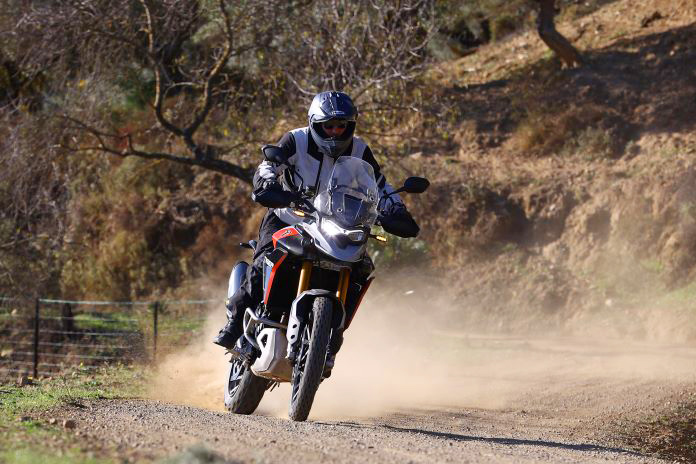
Perhaps the only caveat to lauding the Rally Pro is that it might not be as agile in technical terrain as the KTM 890 Adventure, Husqvarna Norden 901, or some smaller-displacement bikes like Yamaha’s Ténéré 700 or Suzuki’s V-Strom 800DE. But the Tiger has an edge as a streetbike, especially with its comfort and convenience features.
Related: 2023 KTM 890 Adventure First Ride Review
We were also treated to a performance by Triumph’s factory racer Iván Cervantes. The Spaniard’s brilliance on a large ADV was mind-blowing, riding it around as if it was just a big dirtbike. This shouldn’t be a surprise, as Cervantes has ridden Tiger 900s to victories in the 2022 Baja Aragón Rally Trail Class, the Hard-Trail class in the 1000 Dunas Raid, and the Maxi-Trail class in the Bassella Enduro. His talent on a motorbike is exceptional and inspiring – and humbling.
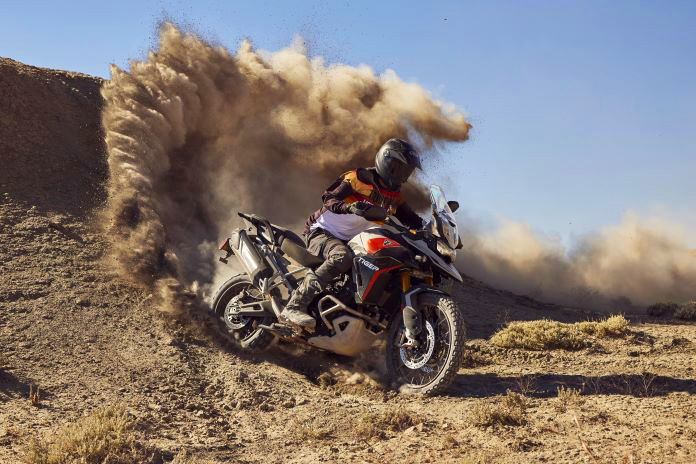
It’s a little anticlimatic to review a bike I already liked after it’s been improved, but that’s the case with the Tiger 900 family. It was previously a platform worth parking in your garage, and now it’s even better.
The new TFT instrumentation pleases eyes and is easy to navigate, the ergonomic triangle with comfier seats allows for long days on the road, and heated touchpoints keep riders warm even if ambient temperatures would indicate otherwise.
Most impressive is the invigorated character of the Tiger’s T-plane engine. It growls with a guttural bark rather than singing like its Triple-powered stablemates, and its newfound top-end lunge is delightful. A smoothly operating up/down quickshifter keeps the motor on the boil and ready for action.
The only caveat to a full-throated endorsement of the Triumph Tiger 900 is the bounty of appealing competitors in the class. Along with the aforementioned KTMs and Huskys are Ducati’s Desert-X and Suzuki’s V-Strom 1050, plus Honda’s amiable Africa Twin and the new Transalp. In terms of value, it’s tough to beat Yamaha’s recently upgraded T7, and BMW will soon give us a ride on its overhauled F 900 GS.
Riders looking for a soft-roader ADV can get the base GT for a reasonable $14,995 or take a jump to $16,895 for the fully featured GT Pro. The Rally Pro has an MSRP of $17,395. Shoppers for middleweight adventure bikes are truly spoiled for choice these days.
The post 2024 Triumph Tiger 900 Review | First Ride appeared first on Rider Magazine.
Source: RiderMagazine.com

MotorLand Aragon hosted Round 10 of the 2023 MOTUL FIM Superbike World Championship and what looked like it could’ve been a straightforward weekend for Alvaro Bautista (Aruba.it Racing – Ducati) was anything but. In contrast, teammate Michael Ruben Rinaldi was back to his best, and returned to winning ways in Ducati’s big moment of need. Re-watch the Race 1 and Race 2 action right HERE and check out highlights of the Tissot Superpole Race on YouTube – don’t forget to subscribe to the WorldSBK channel too!
The reigning Champion headed into the Aragon Round as clear favourite, leading the title race and looking to put one hand on the Championship before the next round. However, Saturday did not go his way. A crash at Turn 8 when leading comfortably dropped him to the back of the field before he was able to recover into the points-paying positions. Looking to make a move for P14 on the final lap, the Spaniard came off his bike again and scored no points. Despite the disappointment for the #1, there was joy on the other side of the box as Michael Ruben Rinaldi took full advantage to win his first race in two years. It was the scene of his first WorldSBK win back in 2020 and his latest too, despite being replaced at the team for 2024 by Nicolo Bulega. Mixed emotions in the Aruba Ducati box, but Bautista had the consolation of still leading the title race.
What are you waiting for? Relive an unforgettable 2023 season in style using the WorldSBK VideoPass!
Source: WorldSBK.com
Source: Jonathan Rea On Facebook
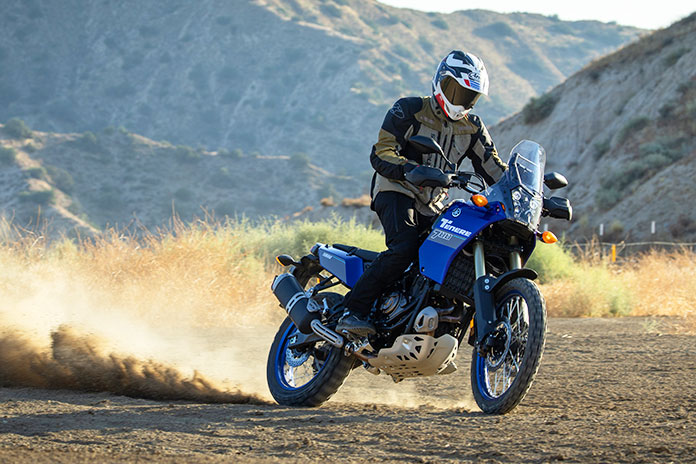
When the Yamaha Ténéré 700 was introduced in the summer of 2020, it was a rare bright spot during the dark time of lockdowns, masks, and toilet paper shortages. It was a new entry in the middleweight adventure bike class, slotting between Yamaha’s WR250R and 1,200cc Super Ténéré. Unlike midsized ADV models from BMW, KTM, and Triumph, Yamaha took a “less is more” approach with the Ténéré 700 – aka the T7 – eschewing electronic rider aids and other costly features and pricing it well below the competition at $9,999.
Contributing photographer Kevin Wing attended the T7’s debut in Tennessee, and he took a shine to it. “As someone who spends most of his time on lightweight dirtbikes without any electronic interventions, I felt immediately comfortable on the Ténéré 700 with its light clutch, smooth shifting, and excellent fueling,” he wrote in his test for the August 2020 issue (see Wing’s 2021 Yamaha Ténéré 700 review here).
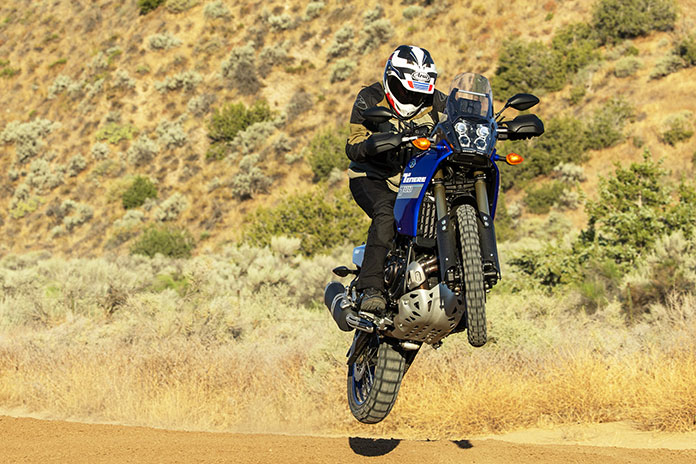
When long-time contributor and dual-sport aficionado Arden Kysley got his hands on our Ténéré 700 test bike in California that same year, he added some factory luggage and other accessories and hit the road for 3,000 miles. “In my local mountains or out in the desert, the T7 has been an excellent partner for exploration, corner carving, and flat-out movin’ down the road,” he wrote in his 2021 tour test review. Kysely liked the T7 so much, he sold his 2009 BMW F 800 GS – which had 65,000 adventure-heavy miles on its odometer – and bought our test bike from Yamaha.
Consistent with the no-frills theme of the original, when Yamaha updated the Ténéré 700 for 2024, it didn’t go overboard. The monochrome LCD screen, which Wing and Kysely said required too much scrolling to access key info and was rendered useless when powdered with trail dust, has been replaced with a 5-inch color TFT display with smartphone connectivity. Like the old screen, the new one has a rally-style vertical orientation, and it now has two display modes: Explorer and Street.
Related: Backcountry Discovery Routes: Two Buddies on Yamaha Ténéré 700s in Utah and Arizona
Other updates include an additional ABS mode. Whereas the previous model’s ABS was only switchable between On and Off, the 2024 model also has an Off-Road mode that deactivates ABS at the rear only. To better access settings and menus on the TFT display and change ABS mode, there’s a new scroll wheel on the right switchgear. There are also sleek new LED turnsignals with clear lenses that replace homely amber “pumpkin” indicators, and the T7’s wiring harness has been updated to accept Yamaha’s plug-and-play accessory QSS quickshifter ($199.99), which allows for clutchless upshifts.
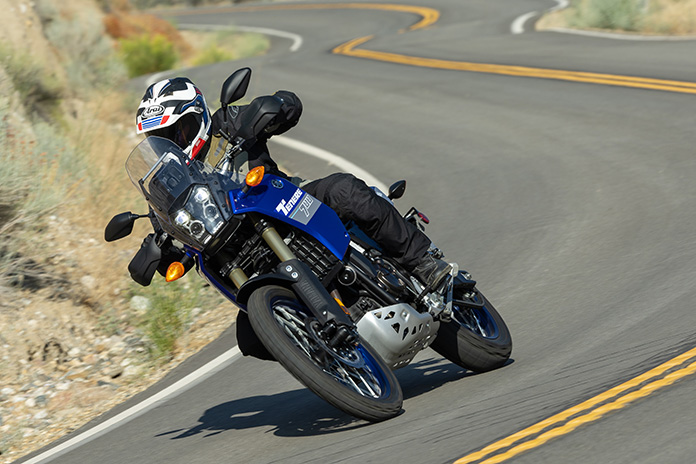
We had been testing a 2023 T7 for several months – that’s the bike you see on the cover and in the action shots, ridden by our capable contributor Thad Wolff – when Yamaha hosted a one-day launch for the 2024 model in December. I rode our 2023 test bike down to Yamaha’s SoCal headquarters, swapped it for a 2024 fitted with a quickshifter, and racked up a few hundred more on- and off-road miles.
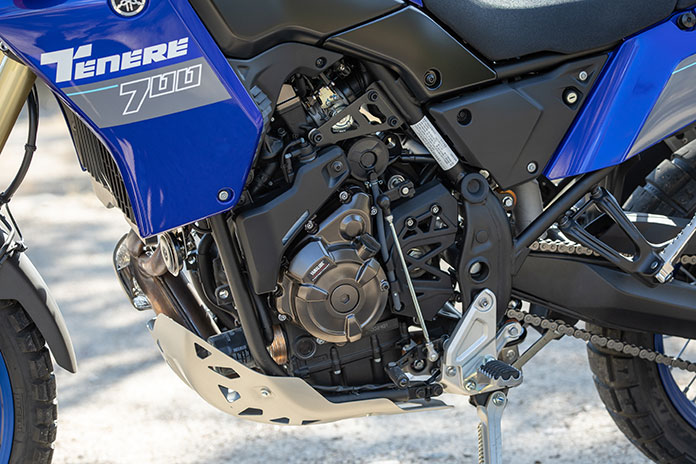
Sending power via chain to the T7’s rear wheel is Yamaha’s CP2 689cc parallel-Twin, the same compact engine also found in the MT-07 naked bike, YZF-R7 sportbike, and – in highly modified form – MT-07 DT racebike that’s used in American Flat Track. For T7 duty, the engine gets a dedicated airbox, cooling system, ECU settings, and exhaust system.
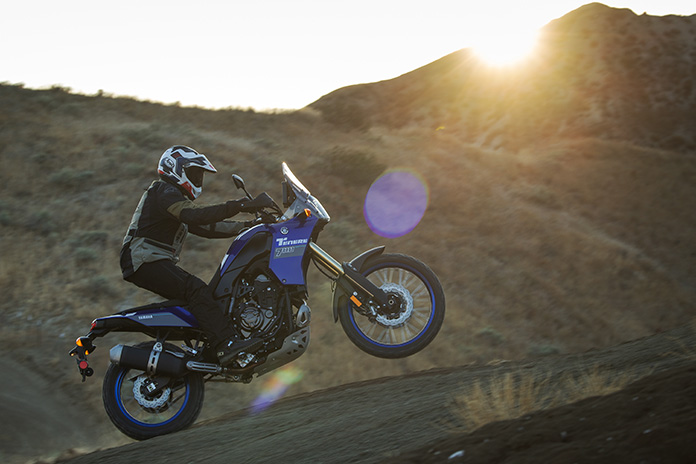
The Twin’s 270-degree crankshaft provides more evenly spaced power pulses than a 180-degree crank. It also produces a torquey feel and a lively exhaust note yet runs smoothly throughout the rev range. Fueling is spot-on, and power delivery is linear, reaching a peak of 63 hp at 9,000 rpm and 43 lb-ft of torque at 6,500 rpm at the rear wheel, as measured on Jett Tuning’s dyno. There are no ride modes, selectable engine maps, or traction control; just calibrate the twist of your wrist for direct results.
Holding the T7 together is a durable steel perimeter frame with a double-braced steering head and removable lower frame rails for engine maintenance, and the steel trellis subframe is welded to the main frame. The long cast-aluminum swingarm enhances rear-wheel traction, and the distance between the axles is a lengthy 62.8 inches.
Sitting or standing on the Ténéré 700, it feels very narrow between the knees. The two-piece seat is long and slender, with a flat section that slopes down from the pillion to its lowest point directly above the footpegs and then continues up onto the tank. If the 34.4-inch seat height is too intimidating, Yamaha offers some relief with a low seat ($129.99) that reduces height by 0.8 inch and a lowering kit ($114.99) that drops seat height by another 0.7 inch, bringing the seat down to 32.9 inches.
For our test on the 2024 model, we opted for the accessory one-piece rally seat ($219.99), which has cover material that’s less grippy than the stock seat and a flatter surface that makes it easier to slide fore and aft when riding over uneven terrain. By eliminating the lower dished section, the rally seat has thicker foam and sits at a lofty 36 inches.
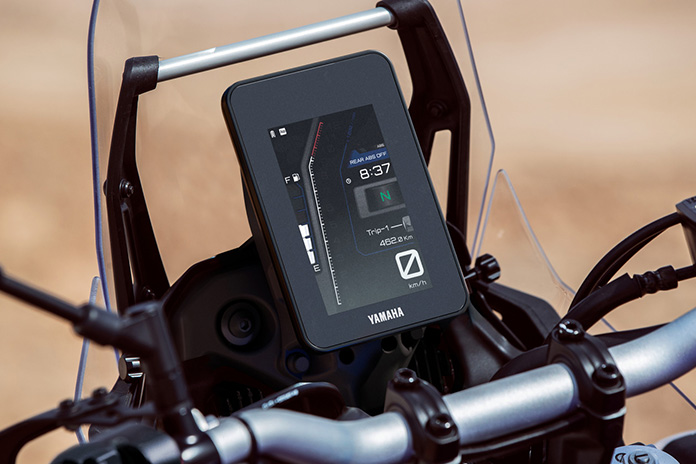
The popularity of adventure bikes is largely due to their versatility. The Ténéré 700 can go just about anywhere and do just about anything, and it’s aimed at riders who place a high importance on off-road capability. Its 21-inch front and 18-inch rear wheels are better for rolling over technical terrain and accommodate a wider variety of knobby tires than the 19-inch/17-inch wheels found on many adventure bikes.
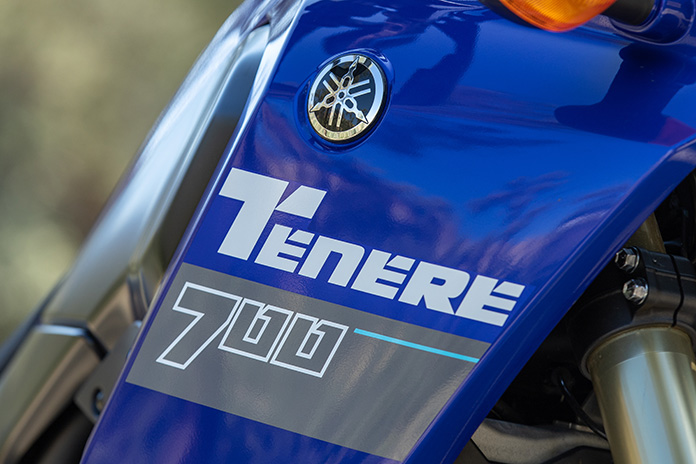
The T7’s Pirelli Scorpion Rally STR tires have a 70/30 on/off-road bias, and they work quite well in the dirt yet also provide decent grip on pavement without being noisy at highway speeds. The T7 also has tube-type spoked rims, which are light and will take a beating, but they make flat repairs a more involved process than with tubeless tires.
Furthering the Ténéré 700’s off-road prowess is fully adjustable long-travel KYB suspension, which has good damping and soaks up big hits and dips like a champ. During the off-road portion of our photoshoot, Thad Wolff said he felt comfortable right away, allowing him to slide, jump, and wheelie the T7 like a big dirtbike. During my off-road ride through the mountains of Cleveland National Forest, I had fun jumping the T7 off water bars and lofting the front wheel over small gullies on the trail, maneuvers that were made easier by the bike’s 48% front/52% rear weight bias and 9.4-inch ground clearance. I appreciate the new Off-Road ABS mode because it provides more confidence in the front on sketchy, loose terrain while allowing rear-wheel skids or slides. The T7’s 452-lb curb weight is comparable to other bikes in its class. Though it’s light for a streetbike, its weight needs to be respected when riding off-road.
But when the trail ride is done, and you’ve got miles of slab ahead of you – like the 100 miles of pavement on my route home after the press launch – the Ténéré 700 adapts like a chameleon to the new environment. Its rally-style windscreen is small but does a good job of managing airflow. The engine runs smoothly at highway speeds, and the 4.2-gallon tank was good for more than 200 miles at the 49-mpg average we recorded during our test, which included some aggressive throttle twisting. On the downside, there is no cruise control, and the stock seat leaves much to be desired for the long haul. If the taller (and thicker) rally seat isn’t a viable option, there are aftermarket saddles from companies like Seat Concepts.
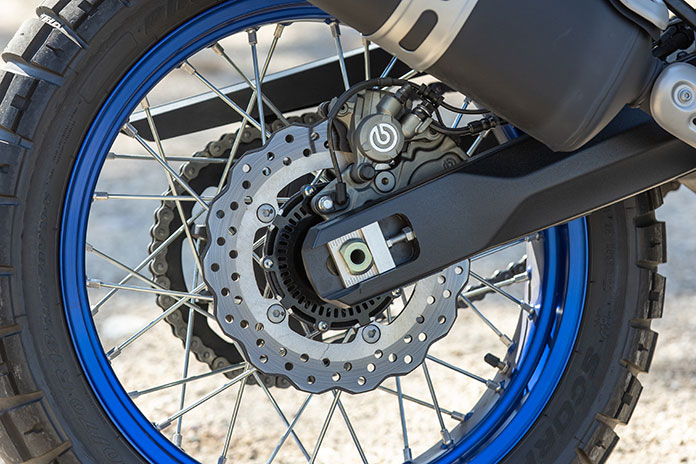
On twisty pavement, the Ténéré 700 handles with confidence without any untoward turning resistance from the 21-inch front wheel. Its torquey Twin, moderate weight, wide handlebar, and narrow tires help the T7 rail through curves like an overgrown supermoto, and its brakes shed speed competently if not impressively.
Related: A Yamaha Ténéré 700 Adventure from Biarritz, France, to the Bardenas Badlands
When it comes to test bikes, I’m promiscuous. As a Rider staffer, I’ve tested hundreds of motorcycles over the past 16 years. But when it comes to personal bikes, I’m a serial monogamist. Soon after getting hired, I started borrowing former EIC Mark Tuttle’s Kawasaki KLR650, which is the bike I cut my off-road teeth on. After lots of cajoling, Mark finally sold me the KLR, and the bike and I enjoyed several faithful, adventurous years together. Eventually, having grown tired of the KLR’s finicky carburetor and lack of power, I got the seven-year itch. I sold it and bought our lighter, more powerful 2017 KTM 690 Enduro R test bike. It’s fantastic off-road, but its vibration and lack of comfort on the road get old quick.
Related: White Rim Trail on KTM 690 Enduros | Favorite Ride
So here I am, at a crossroads, wondering what to do next and seriously considering the new Ténéré 700 for my own garage. Thad Wolff also really likes the Ténéré 700, especially its price, simplicity, and capability, and he could see himself owning one, though he’d like to make a few modifications to improve its comfort and touring ability. I agree on all counts, and Arden Kysely’s 2021 tour test and his long-term reviews of the T7 cover some useful upgrades. Arden now has nearly 17,000 trouble-free miles on his T7, and he’s a satisfied owner – an endorsement that further stokes my desire for the T7. To help me decide, I’ll keep our test bike for as long as possible, tailor it to my needs, and report on the experience. Stay tuned.
Check out more new/updated bikes in Rider’s 2024 Motorcycle Buyers Guide
The post 2024 Yamaha Ténéré 700 Review | Rider Test appeared first on Rider Magazine.
Source: RiderMagazine.com

The French Round was the ninth round of the 2023 MOTUL FIM Superbike World Championship and it delivered in style. The Saturday action was still fresh in everyone’s minds when Toprak Razgatlioglu (Pata Yamaha Prometeon WorldSBK) and Jonathan Rea (Kawasaki Racing Team WorldSBK) started duelling on Sunday in Race 2. The pair were inseparable during the final race of the weekend as they traded paint during an epic fight. Check out all the action from Race 1 and Race 2 HERE and watch highlights from the Tissot Superpole Race on YouTube – don’t forget to subscribe too!
With 15 laps to go, their battle began to heat up. Rea made a move for second heading into the Turn 5 hairpin, a scene of so many overtakes at the iconic venue, with the #54 trying the cutback on his adversary. The battle continued to heat up as the race progressed, and, with 12 laps to go, the six-time Champion got ahead of Razgatlioglu. A dozen laps later and the pair were at it again, Turn 5 once again the scene, as the Yamaha star moved his way back into second. The battle raged on for the final six laps as both looked to secure second, behind Alvaro Bautista (Aruba.it Racing – Ducati) who had escaped up the road. Watch the unmissable fight in the video at the top of this page.
What are you waiting for? Relive an unforgettable 2023 season in style using the WorldSBK VideoPass!
Source: WorldSBK.com
Since the first issue of Rider’s 50th anniversary year, which includes this Tourmaster Ridgecrest Mesh Adventure jacket and pants review in Gear Lab, is making its way to reader mailboxes, I decided to look up the issue in which we published our first Tourmaster product review. In the January 1993 issue – 31 years ago! – former editorial director Bill Stermer reviewed a pair of Tourmaster Grand Tour Elite Gloves.
Tourmaster is one of the in-house apparel brands sold by Helmet House, a distributor founded in 1969 by Bob Miller and Phil Bellomy, who started out selling helmets on weekends at swap meets in Southern California. As our long-time readers know from our many Tourmaster reviews over the years, the brand has a full line of jackets, pants, boots, gloves, heated gear, raingear, luggage, and motorcycle covers designed for touring riders.
The Tourmaster Ridgecrest Mesh Adventure jacket and pants combo is part of the apparel brand’s Horizon Line aimed at ADV riders, but it’s suitable for anyone looking for a versatile set of three-season gear at a reasonable price – MSRP is $239.95 for the jacket and $189.99 for the pants. The outer shell of both garments is made of abrasion-resistant 600-denier polyester and high-flow mesh with 1000-denier honeycomb nylon ripstop reinforcements in high-impact areas. Additional protection comes from removable CE Level 2 armor at the shoulders, elbows, and knees and EVA foam padding at the back and hips, while stretch panels in key locations enhance freedom of movement.
To keep out wind and rain, both garments have lightweight, removable, breathable Reissa liners, and the jacket also has a removable thermal vest liner. Fit adjusters and reflective accents abound, and an 8-inch zipper at the lower back connects the jacket to the pants. ADV and touring riders love pockets, and the Ridgecrest set doesn’t disappoint. On the jacket, there are six on the front, two inside, and two on the back, one of which is a huge cargo pocket that’s a great place to store liners when not in use. The pants have four pockets, and the two jacket liners have a total of three pockets.
The Tourmaster Ridgecrest performed well during the two-day press launch for the new BMW R 1300 GS. On cold mornings and high-elevation mountain rides, the liners blocked the wind and kept me warm. During the exertion of off-road riding, the mesh gear allowed plenty of airflow to shed excess body heat. The jacket and pants were comfortable (the stretch panels were much appreciated) and fit was quite good, though the jacket sleeves were a tad short for my long monkey arms. Check the sizing chart to ensure you order the correct size – the best fit for me was a large jacket and medium pants.
The Tourmaster Ridgecrest Mesh Adventure jacket is available in Black, Hi-Viz, Navy, or Sand, and the pants are available in Black or Sand/Grey. Both items come in a wide variety of sizes, including Short, Tall, and Plus options.
See all of Rider‘s Apparel Reviews here.
The post Tourmaster Ridgecrest Mesh Adventure Jacket and Pants | Gear Review appeared first on Rider Magazine.
Source: RiderMagazine.com

The first MOTUL FIM Superbike World Championship action after the August break was at the Circuit de Nevers Magny-Cours with plenty of drama from the off. Saturday featured an unexpected pole position for American star Garrett Gerloff (Bonovo Action BMW) but one of the key stories from the French Round was the collision between Aruba.it Racing – Ducati teammates Alvaro Bautista and Michael Ruben Rinaldi while fighting for the top positions. Check out all the action from Race 1 and Race 2 HERE and watch highlights from the Tissot Superpole Race on YouTube – don’t forget to subscribe too!
Gerloff became the first American in 12 years to take a pole position in WorldSBK when he stormed to top spot in Saturday’s Tissot Superpole session. He was unable to convert it into a podium finish but still reminded everyone of his and BMW’s potential with strong pace throughout the weekend. However, all eyes were on the Aruba Ducati box in the Superpole Race when Bautista, Rinaldi and Toprak Razgatlioglu (Pata Yamaha Prometeon WorldSBK) were fighting for top positions. Heading into Turn 5, the Spaniard hit the back of his teammate’s Panigale V4 R and forced him out of the race. No action was taken following an investigation by the FIM Stewards, and Bautista was understandably apologetic when he returned to the box.
What are you waiting for? Relive an unforgettable 2023 season in style using the WorldSBK VideoPass!
Source: WorldSBK.com
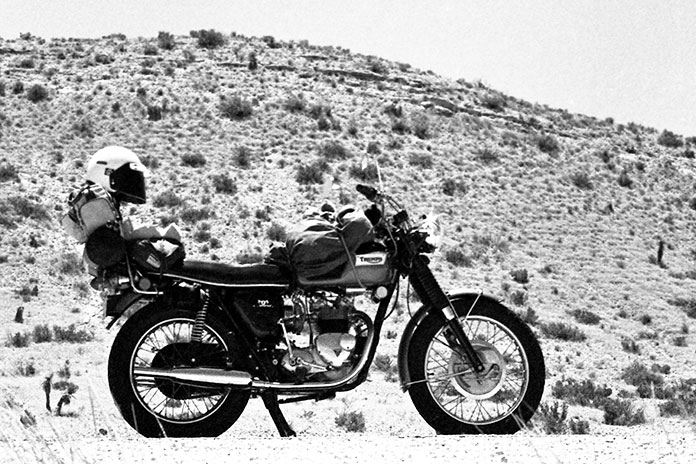
In May 1974, my wife and I, then students at Baylor University in Texas, took advantage of the break between semesters to ride two-up on a 1971 Triumph Daytona T100R from Waco, Texas, to the California coast – our first long-distance adventure together.
At the time, we had been married for three years. I was a doctoral student in clinical psychology and worked part-time at a Gulf filling station, largely because the McDonalds next door gave free Big Macs to the Gulf employees. My wife was an undergraduate majoring in liberal arts and journalism as well as a photographer. For our trip, she packed rolls of black-and-white film and strapped a tripod on the back of the bike. We had no saddlebags or storage compartments. For a trip of 4,200-plus miles over 18 days, we traveled light: helmets, jackets, a change of clothes, a few tools and chain oil, and photo gear.
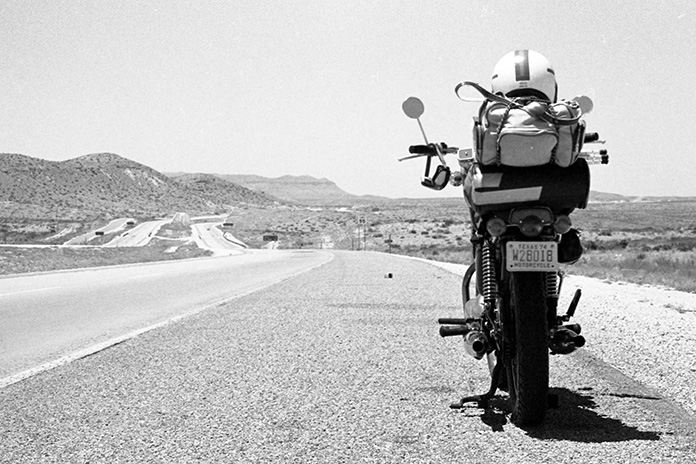
I had handpainted my Bell 500TX helmet with red, white, and blue stripes and affixed a small peace-sign-with-stars decal on each side. Hidden inside the helmet were the words “free, to be, to become” – my mantra then and now.
With no cellphones or GPS, our “navigation” was a Kawasaki Good Times Vacation Guide and Road Atlas strapped on top of my clothes bag, which was bungee-corded to the gas tank.
The Triumph Daytona was produced from 1967-1974 and had an air-cooled 490cc parallel-Twin with a 4-speed gearbox, chain final drive, drum brakes, and a kickstarter that could definitely kick back. It had a right-hand throttle, left-hand front brake, right-foot gear shifter, and a left-foot rear brake.
The single weak headlight, taillight, and Smith gauges were illuminated by the electronics of Joseph Lucas – aka the “Prince of Darkness.” Night riding with Joseph with no lights was a frequent thrill!
My Triumph Daytona was a piece of British driftwood in a Japanese sea of Hondas, Yamahas, Kawasakis, and Suzukis. The ride was like a runaway jackhammer on the interstate, but over the course of the trip, the Triumph performed flawlessly, dripping just a drop or two of oil on the ground and only needing its chain lubed.
For the first 300 miles of the trip, hot headwinds of 20-30 mph buffeted us. Looking in the mirrors, I couldn’t see the whites of my eyes – only red.
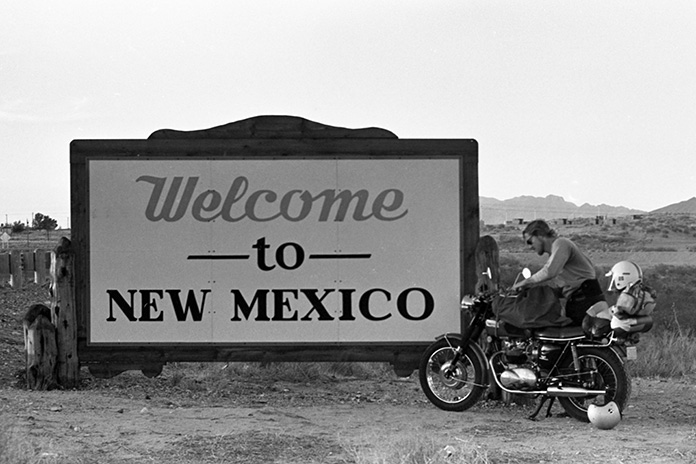
The Triumph had no odometer or gas gauge for its 2.5-gallon tank. At one point, the engine sputtered, and I knew we were running out of gas. I reached down under the tank and switched on the reserve petcock, and the engine fired back up. We were good for maybe 6 miles, but the closest town was 15 miles away.
When the bike sputtered again and gradually coasted to a stop by the side of the road in the middle of nowhere, I thought we were cooked. But in a stroke of deus ex machina, a Texas Highway Department truck appeared as if in a mirage, stopped, and had a full gas can. We couldn’t believe our good fortune and were so grateful!
We would end up topping off the gas tank several times in Texas at an average of 57 cents per gallon. Motel rooms ranged from $8 to $9 per night.
In New Mexico, we saw the Rio Grande with Mexico on the other side. Globe, Arizona, was all about copper, silver, and gold mining – ruggedly beautiful mountain country.
In California, we rode from Laguna Beach up the coast. One of the best roads was State Route 1 from Cambria up through Big Sur to San Francisco. My focus alternated from the blue ocean to the curvy switchback-filled two-laner cut into the side of the mountains high above the sea.
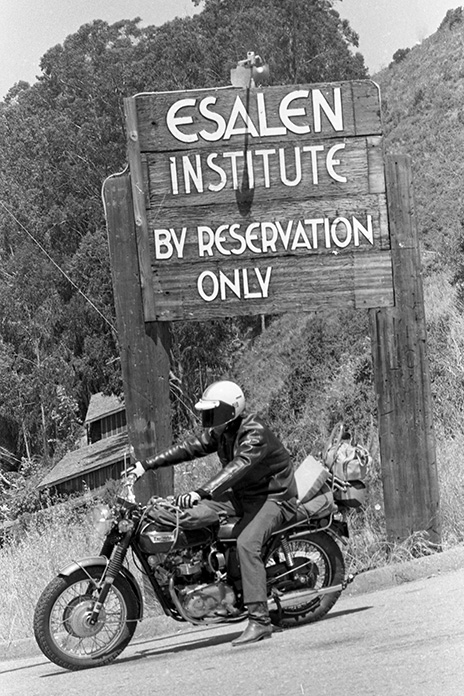
The Golden Gate Bridge was a high point of our journey. In the bright sun, the painted steel looked golden orange above the dark blue water. As we approached the entrance – surprise! – a BSA pulled up right beside us. Two English bikes riding side by side on the Golden Gate Bridge. What a rush. I still get a big smile thinking about it. We rode back and forth a couple of times across the bridge – we just couldn’t get enough – and with no fairing, totally exposed, it felt like we were flying, suspended in air, over the ocean.
Then we rode inland and up into the Sierra Nevada to Lake Tahoe, where we touched snow in 70-degree weather at 7,000 feet. It was hard to make a snowball, but we climbed partway up a mountain and slid down a snowbank.
From Tahoe, we rode through Nevada on U.S. Route 50, known as “The Loneliest Road in America.” There were no houses, stores, gas stations, signs, animals, birds, or crickets, only the vast expansiveness of wide-open valleys. I felt direct, pure, unadulterated contact with Mother Earth. My yell was rapidly engulfed by the vastness with not a trace of an echo returning to me.
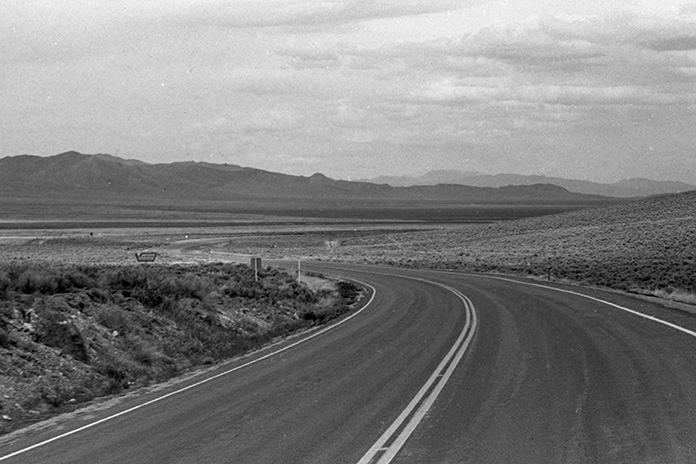
We continued southeast into Utah and Arizona, through the Hopi Indian Reservation, and later stayed at the lodge on the North Rim of the Grand Canyon, a source of great energy. Looking down through the layers of the Earth, I could feel its raw, latent power. So this is what you’ve been hiding from me as I walk on top of you! I thought. Even stripped naked, with all its layers worn and peeled away, the Earth demanded respect, if not awe.
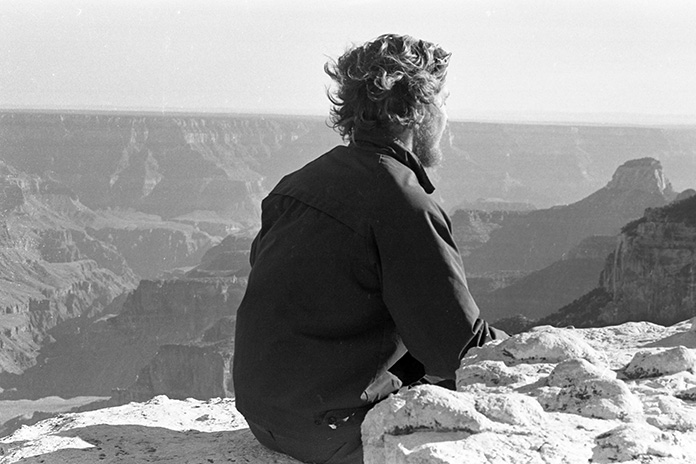
The Smith odometer on the Triumph Daytona showed 11,225 miles at the start of the trip and 15,429 miles at the end, for a total of 4,204 miles. I recorded each day’s mileage in a small notebook. The shortest riding day was 217 miles, the longest was 453, and four of the five trip days averaged 350-plus miles.
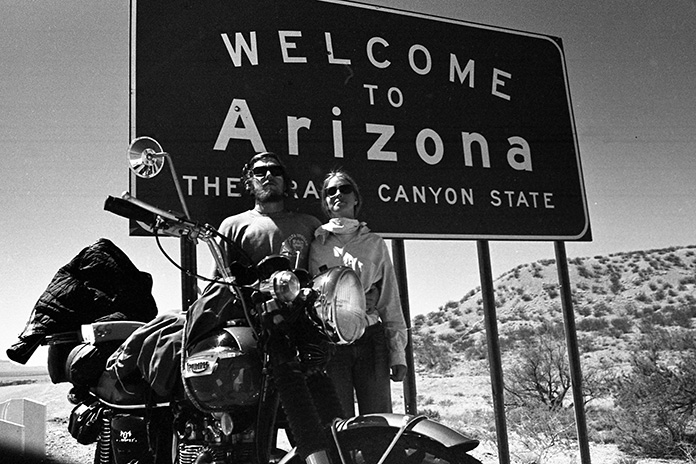
Fifty years later – despite my wife and I living on food stamps during the years we were both in school, running out of gas numerous times, riding in bone-freezing cold, and riding in the night with no lights – the photographer and the author who took that trip in 1974 are still two-up, now alternating positions, on this magical mystery tour and adventure called life.
See all of Rider‘s touring stories here.
The post Two-Up on a 1971 Triumph Daytona from Texas to California appeared first on Rider Magazine.
Source: RiderMagazine.com